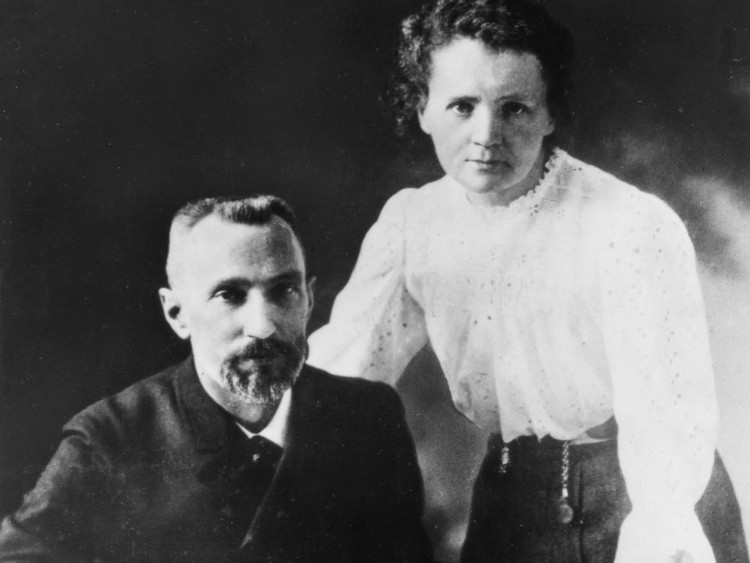Marie Curie and her family won 5 Nobel Prizes
Marie Curie and her husband have won all 5 Nobel Prizes in 3 different fields but the passion for science also led the Curie mother and daughter to the same disease.
French-born Polish physicist Marie Curie was the first to win two Nobel Prizes, and to this day, she is still one of the only two people to ever get a Nobel Prize in two different fields.
In 1903, the couple Pierre and Marie Curie shared the Nobel Prize in Physics with the French physicist Henri Becquerel . Becquerel was awarded for his discovery of natural radioactivity , while the Curies were recognized for their study of the radiation detected by Becquerel.

Marie and Pierre Curie.(Photo: Wikipedia).
In 1911, Marie Curie won the Nobel Prize in Chemistry with the achievement of discovering two elements, radium and polonium.
Following the family's scientific tradition, the daughter of Pierre and Marie Curie, Irene Joliot-Curie, was awarded the Nobel Prize in Chemistry with her husband, Frédéric Joliot-Curie, in 1935.
In 1965, the son-in-law of Marie Curie, husband of the second daughter of Curie, Henry Labouisse - then director of the United Nations Children's Fund (UNICEF) - the organization's representative received the Nobel Peace Prize.
Nobel prize trouble
In 1906, Pierre Curie died of a road accident. A few years later, Marie Curie found new love.Paul Lengevin was also an outstanding scientist, a few years younger than Mrs. Curie and a former student of her husband.
Lengevin is portrayed as a handsome, tall man, an outstanding scholar and a devoted researcher.
There was only one problem, Lengevin was married and had 4 children. Their love was not over the eyes of his wife Lengevin.

Marie Curie and her two daughters, Irene and Eve.(Photo: Br.de).
In 1911, the Nobel Committee announced Curie was awarded the second Nobel Prize in her career. At the same time, Lengevin's wife published the Curie love letters to the Lengevin to the press, according to Lauren Redniss's Radioactive book about the life of Curie.
Near the Nobel ceremony in Stockholm, Sweden, many people - including members of the Nobel Committee - called on Curie not to attend the awards ceremony to avoid causing trouble. Meanwhile, Albert Einstein encouraged Curie "should look down on those rubbish" and go to Stockholm.
Finally, Marie Curie went to Sweden to receive the award and the awards ceremony went well, without any interruption.
The path of Curie
Irene Curie - the first daughter of Pierre and Marie Curie - had chosen exactly the way her mother had gone: marrying a scientist and winning a Nobel Prize with her husband.
After marriage, both Irene and her husband, Frederic Joliot, took the last name of Joliot-Curie . The Joliot-Curie married the Nobel Prize for Chemistry in 1935 for work on artificial emission , following Marie Curie's discovery of natural radioactive elements.
More interestingly, Irene Curie's doctoral dissertation instructor was Paul Lengevin, her mother's long-time lover.
The only person of the Curie family who did not follow the scientific path was the second daughter Eve Curie. Eve Curie was dear and close to her mother but unlike Irene, Eve did not share her passion for science with Marie Curie.
Instead, she was more interested in humanities. She writes, writes a newspaper and later becomes a social activist. Finally, she still married a Nobel laureate.
In 1965, UNICEF was awarded the Nobel Peace Prize for "facilitating the completion of the Nobel's will, encouraging brotherhood among nations" and participating in the development process of the world as a "factor. important for peace ".

The couple Irene and Frederic Joliot-Curie in the laboratory.(Photo: Wikipedia).
Eve's husband Denise Curie Labouisse (named after Eve Curie's marriage), Henry Labouisse received the award as UNICEF director at the time.
Marie Curie died in 1934 because of leukemia, a common disease of radiation research scientists. My daughter Irene died of the disease in 1956. However, the Curie family's scientific story does not stop there.
Helene and Pierre - Irene Joliot-Curie's two children and still alive - are renowned French scientists.
Helene Langevin-Joliot (currently 89 years old) also studied radiation like her mother and grandmother, she was a famous nuclear physicist and held an advisory position for the French government. Meanwhile, her brother Pierre Joliot-Curie (84) is a biologist who worked at the French National Center for Scientific Research.
More specifically, Helene's husband is Michel Langevin , Paul Langevin's grandson.
Therefore, there were people joking that the Curie family had a passion for science and the Langevin men.
- Strange family has a Nobel Prize
- Marie Curie - From a hired girl to twice receiving a Nobel Prize
- The most famous Nobel prizes in history
- New title for Marie Curie
- Marie Curie built a scientific dream from a shabby lab
- 1500 years later, Marie Curie's notebook still had no radiation
- Did you know the Four Great Kings of the world science village?
- Euro 50,000 for recipients of the Marie Curie Award 2006
- Women who won Nobel prizes
- Marie Curie - The most famous female doctor in the world
- The discovery of Marie Curie's radioactive substance
- Grandson Marie Curie came to Vietnam to pass on her passion for young people
 The most famous scientific failures in history
The most famous scientific failures in history Mysterious genius mechanic and the machine froze time
Mysterious genius mechanic and the machine froze time The son carries the 'bad gene' of genius Albert Einstein
The son carries the 'bad gene' of genius Albert Einstein Isaac Newton
Isaac Newton